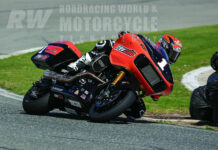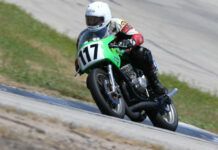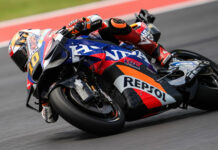MotoGP set-up report – Le Mans, France Le Mans, France 9/5/2005 Round 4: Le Mans, France Track length: 4180 m Opened: 1965 Fastest Lap Ever: 1:34.088 (Max Biaggi, 2004) MotoGP lap record: 1:34.088 (Max Biaggi, 2004) Last year MotoGP winner: Sete Gibernau 2004 MotoGP race summary Carlos Checa took a well-earned second in the 2004 French Grand Prix after a close-fought race with Sete Gibernau (Honda) in Le Mans, France. Although his Yamaha team-mate Valentino Rossi was unable to overcome the set-up problems which had plagued his YZR-M1 all weekend, the young Italian still finished a strong fourth after a hard fought battle with Max Biaggi (Honda). Checa managed a strong start from second place on the grid to immediately take the lead, with Rossi in third. Pole-sitter Gibernau gradually closed the gap from behind before overtaking Checa on lap 11 and then continuing on to take his second successive Grand Prix win of the year. Meanwhile Biaggi made his move on Rossi and before making up the lost ground on Checa. The Spaniard rode a hard race to fend off the Roman Emperor, eventually crossing the line just three tenths of a second ahead of Biaggi. In the midst of all this Rossi closed the gap between himself and Biaggi, considerably, in the closing stages – passing him momentarily on lap 25, but was unable to stay ahead at the line. 2005 Set-up report YZR-M1 Le Mans is a circuit made up of a number of second gear hairpins linked together by a series of long straights, with only the occasional chicane breaking up the run to the next hairpin. A design of the past, the French circuit causes little concern for engineers regarding set-up. Turns three and five are the most likely passing points and all efforts will be focused towards finding stability under brakes in these areas. The YZR-M1 therefore requires a heavier spring rate on the front to deal with the aggressive weight transfer as the rider dramatically decreases his velocity, while still providing the ability to soak up any bumps entering each of the slower turns. The latter will be taken care of by the Öhlins front-end compression damping. Meanwhile the fork rebound will be dialed in to offer a more controlled return to the fork’s full length. This will be done in an effort to offer stability as the rider makes the somewhat aggressive, almost light switch like transition from the brakes to the throttle in the chicanes. In addition to the heavy fork springs the bike’s attitude will be set to ensure stability with the rear. This is achieved with a slightly lower rear ride-height, lowering the center of gravity, in turn helping to prevent the rear tyre from rising off the track’s surface. Progress made on braking stability throughout pre-season testing and during the first two rounds of the 2005 season will pay dividends at the stop-go styled Le Mans circuit, as will the M1’s lightweight steering character – especially through the quick chicanes. This approach is in fact a compromise, but it’s a set-up that will be the most efficient on a circuit with this classic character. The improved stability will affect the cornering characteristics by reducing its turn-in agility slightly, but experience has shown the Yamaha is one of the most agile bikes in the championship and the slight loss here is minimum compared to the gains made up under brakes. Meanwhile drive off the turns must not be neglected; but with the rear ride-height reduced for stability the ability to hold the racing line, while exiting a corner, is compromised to a certain degree. Therefore a softer rear spring rate will feature on the M1 for good predictable feedback, but it will be dialed in with a high degree of preload to prevent the rear-end from squatting under power as the weight transfers to the back of the bike. As the Le Mans corners are short and sharp the rear shock linkage ratio therefore plays an important role at compensating for the softer spring rate by providing a movement which is initially firmer.
Le Mans Circuit Requires Stability Under Braking
Le Mans Circuit Requires Stability Under Braking
© 2005, Roadracing World Publishing, Inc.






